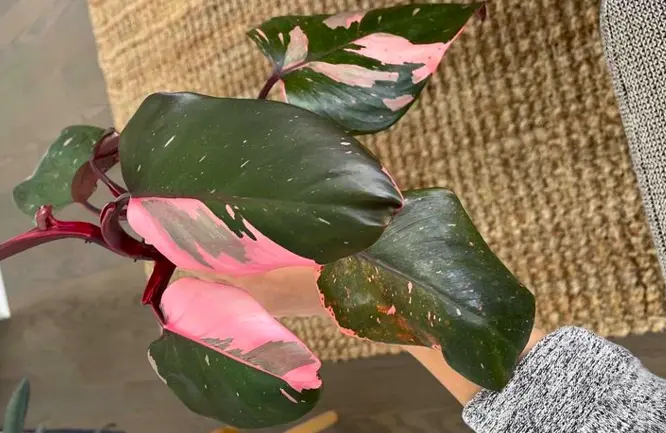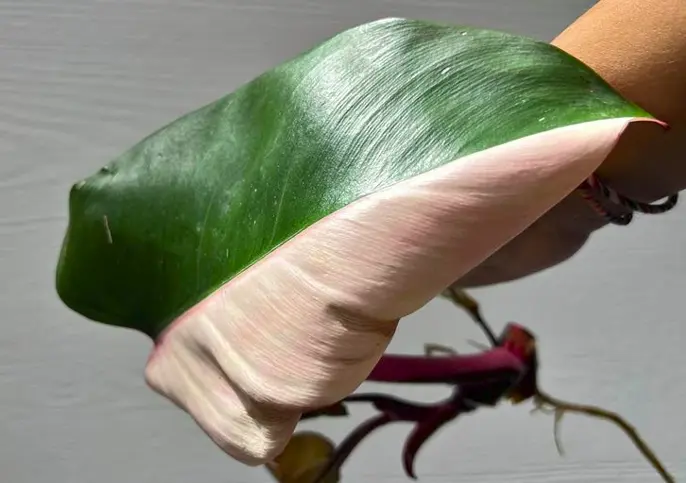The pink princess philodendron is highly sought after by many collectors, and for a good reason.
Much of its popularity comes from the deep green heart-shaped leaves with pink variegation. This unique colorful foliage earns it the name pink princess and makes it a stunning addition to any houseplant collection.
Although they are tough to find, they are as easy to care for as other popular philodendrons, making them an excellent plant for beginners.
Caring for your pink princess philodendron is vital in maintaining its beautiful pink variegation.
In this article, I’ll tell you everything you need to know to grow and care for your plant to enjoy its variegated leaves.
How to Grow Pink Princess Philodendron

Growing a pink princess philodendron is not tricky. All you need to know are the right conditions to provide your plant.
Start your plant in a 6 to 10 inches pot with drainage holes at the bottom. You will need to repot to a bigger container as it grows.
Because this plant is native to the tropics, it would need humidity, warm temperature, and moist soil to grow, so do well to provide your plant with these.
Lastly, choose a location that gets bright light to encourage healthy growth and variegation of the leaves.
How to Care For Pink Princess Philodendron

Now that you know how to grow your pink princess philodendron, we shall discuss how to care for your plant.
There are a few things to take note of to ensure you keep your plant healthy and vibrant.
Provide Enough Light for Your Plant
Sunlight is the most crucial factor to consider if you want your pink princess philodendron to keep its variegation. Without adequate light, the leaves may ultimately become green.
This is due to the chlorophyll content in the leaves. The variegated part of the plant does not contain any chlorophyll, so if the plant gets enough sunlight, it can sustain itself without losing its pink color.
But if the light is too low, the plant will have to produce more chlorophyll to keep up with photosynthesis to produce energy, and the variegated areas would be reduced.
If the plant is left in a low-lit area for too long, it might lose all its variegation, and the leaves would be entirely green.
To prevent this from happening, provide your pink princess philodendron plant with bright but indirect light for six or more hours per day.
Avoid exposing your plant to direct sunlight, as this can burn the leaves, turning them yellow or pale white.
You can supplement your plant with a grow light if it is hard to provide enough light inside the house.
Use an Adequate Soil Mix
Using the right potting mix is essential in keeping your pink princess philodendron alive for a long time.
This plant enjoys airy, nutrients rich soil that drains quickly to prevent any fungal infections but can also keep enough moisture for the plant to use.
You can buy an aroid potting mix for your plant or create the perfect potting mixture yourself.
Combine standard potting soil with perlite, coconut coir or peat moss, and orchid bark to create a potting medium with great consistency but not too heavy.
Water Properly
A common mistake most gardeners make when watering their houseplants is doing too much. Overwatering can cause many growing issues, including root rot and the yellowing of leaves.
Water your plant thoroughly, but only when the top 2 to 3 inches of the soil are dry. Avoid letting the potting mix dry out completely.
Keep Your Plant Warm
Pink princess philodendrons are tropical plants that need a warm environment to survive. However, they adapt pretty well to being indoor plants.
That said, keep your plant in temperatures between 65 to 85 degrees Fahrenheit. This plant can survive a temperature below the lower limit of this range, but extreme cold can kill it.
In the same vein, protect your plant from extreme heat, so keep it away from direct heat sources like fireplaces and hot radiators.
Keep Your Plant in A Humid Environment
Philodendrons are not too fussy about humidity, but keeping your plant somewhere with humidity levels higher than 50% is best.
If the air in your house is too dry, you can boost the humidity around your plant by setting up a humidifier nearby, setting your plant over a pebble tray, or misting often.
The issue with misting is that the extra moisture on your plants’ leaves can attract pests and diseases.
Fertilize Your Plant Regularly
The pink princess philodendron grows best when fed during the growing season. And for those raised in pots, the nutrients in their soil would get depleted over time, so there is a need to replenish the store often.
If you do not top up these nutrients in time, your pink princess growth rate will slow down and stop.
Fertilize your plant once a month with a balanced liquid fertilizer during the spring and summer. Always check the packaging and follow the instructions.
It is better to apply too little than to overdo it because over-fertilizing can burn your plant’s roots.
Stop fertilizing your plant in early fall and winter, as this is its dormant period.
Repot Every Once In A While
There are many benefits to repotting your pink philodendron plant. First, it gives you a chance to refresh the potting mix.
A larger pot would allow the roots more space to grow, preventing them from being overcrowded and encouraging your plant’s growth.
You should repot your plant every 2 to 3 years. Use a pot about 3 inches larger than the old one. Trim the damaged roots before repotting.
Prune Regularly
Pruning your pink princess philodendron has several benefits, including stimulating more growth, preventing leggy growth, and even increasing the amount of variegation.
The best time to prune is just before or after the growing season, in spring or fall. Make a clean cut above the node, where the leaf attaches to the stem.
You can remove any underperforming leaves or stems; new growth will come from the cut end. You can also remove any damaged or dead leaves at any time.
Asides from encouraging new growth, pruning also helps to control the height if there is not enough space in your room.
Protect Your Plant from Pests and Diseases
Pink princess philodendron is susceptible to pests that affect other houseplants, such as mealybugs, spider mites, scales, aphids, and fungus gnats when stressed.
You can get rid of these pests by rubbing alcohol directly on your plant, using a neem oil solution or an insecticidal soap.
Fungal infections like root rot and rust spots can be prevented by avoiding overwatering.
Provide Climbing Support
Like other philodendrons, this plant is a natural climber, climbs tall trees in its natural habitat.
Providing a moss pole to support the growing stems would help your pink princess philodendron attach its aerial roots, helping it climb and grow better.
How to Propagate the Pink Princess Philodendron
While propagating a pink princess philodendron is very easy, it is essential to note that the new plant may not have the same variegation as the mother.
That said, here is how you can propagate your pink princess philodendron.
- Choose a stem that has 3 or 4 leaves with pinkish variegation and cut just below a node.
- Remove any bottom leaves and let it remain just the three at the top.
- Set the cutting aside for some hours to allow the cut edge to be callous over, then place it in a jar of water. After a few weeks, roots would start to grow from the cutting.
- Allow these roots to grow about 2 inches in length, then plant the newly rooted philodendron in a pot containing a light potting mix.
- Please place it in a location that receives bright indirect light and water thoroughly.
Is the Pink Princess Philodendron Toxic?
The pink princess philodendron is as toxic as it is beautiful. Its leaves, stems, flowers, and roots contain varying amounts of calcium oxalate crystals.
Ingestion of any part of this plant can cause irritation, nausea, diarrhea, and vomiting.
In the worst-case scenario, kidney stones can develop in the person due to the buildup of these crystals.
It would be prudent to keep it out of reach of children and pets if you’re worried they might eat it.
